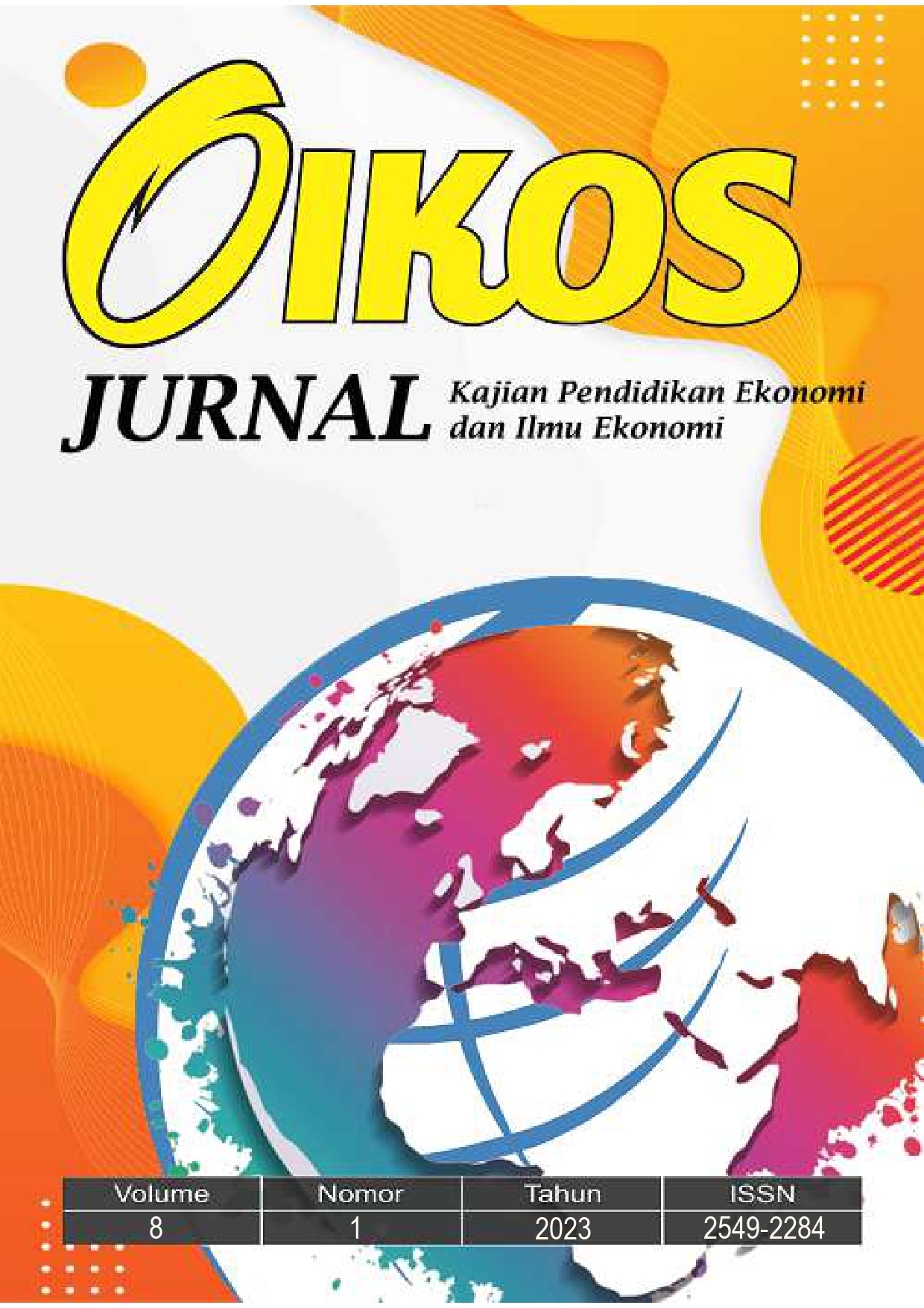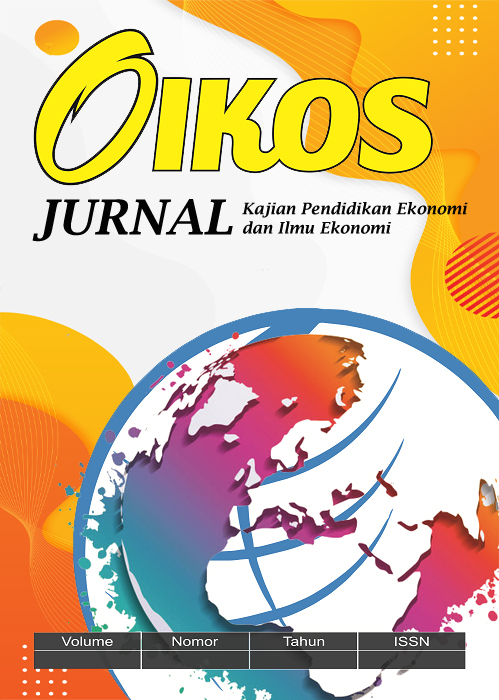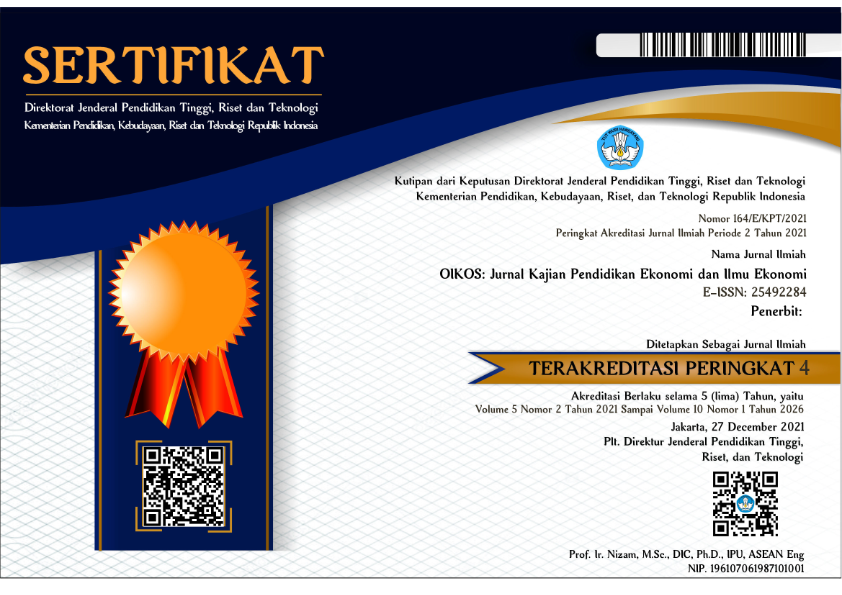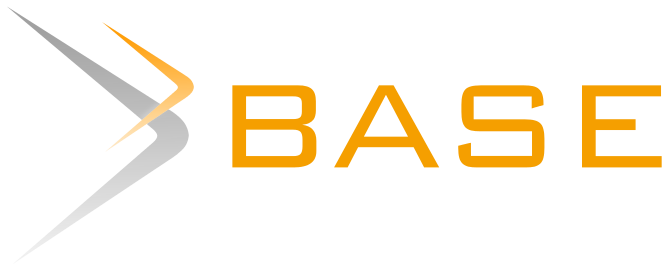THE LEVEL OF STUDENTS' CRETIVITY IN LEARNING FINANCIAL ACCOUNTING IS REVIEWED FROM LEARNING INTEREST
DOI:
https://doi.org/10.23969/oikos.v8i1.12527Keywords:
Minat Belajar, Kreativitas, Hasil BelajarAbstract
The aim of this research is to determine the differences in students' creative thinking abilities in the categories of high learning interest and low learning interest. The research method used is a comparative method with data analysis using the t test (one sample t-test) with ANOVA hypothesis testing. The participants in this research were students from the 2020 class of the economic education study program, Faculty of Teacher Training and Education, Pasundan University. This research was divided into two groups of students, namely the group of students in the high learning interest category and the students in the low learning interest category. interest. Based on the results of hypothesis testing, it is known that there are differences in the creative thinking abilities of students in the high learning interest category and students in the low learning interest category. Learning carried out by teachers must be able to pay attention to students' level of interest in learning because it will influence the learning process and outcomes, including thinking abilities, one of which is creative thinking.
Downloads
References
Almujab, S. (2015). Pengaruh Metode Discovery Terhadap Peningkatan Berpikir Kreatif (Studi Kuasi Eksperimen Mata Pelajaran Kewirausahaan Pada Siswa Kelas XI PS SMKN 1 Bandung).
Anderson, L. W. (2010). Kerangka Landasan untuk Pembelajaran, Pengajaran, dan Aesmen (Revisi Taksonomi Bloom). Yogyakarta: Pustaka Pelajar.
Asep Herry Hernawan, d. (2006). Pengembangan Kuri ku lum dan Pembelajaran . Jakarta: UT Departemen Pendidikan Nasional.
Edora. (2015). Pengaruh Metode Pembelajaran Problem Based Learning Terhadap Peningkatan Kemampuan Berpikir Kritis Peserta Didik. Oikos Jurnal Pendidikan Ekonomi FKIP Unpas.
Dwi, Laksana S. (2018). Integrasi Empat Pilar Pendidikan (Unesco) Dan Tiga Pilar Pendidikan Islam.
Filsaime, T. (2008 ). Menguak Rahasia Berpikir Kreatif dan Kreatif. Jakarta: Prestasi Pustaka.
Gary Coombs, M. E. (2004). Education Introduction To The Special Issue: Problem-Based Learning As Social Inquiry—Pbl And Management. Journal Of Management Education Sage Publication, 28(5), 523–535.
Hidayat, R. &. (2013). Pendidikan Abad 21 dan Kuri kulum 2013. Unpak.
https://data.go.id/dataset/nilai-rata-rata-sekolah-un
Kemendikbud. (2016). Revitalisasi Pendidikan Vokasi.
Komara, Endang. (2018) Penguatan Pendidikan Karakter dan Pembelajaran Abad 21. SIPATAHOENAN: South-East Asian Journal for Youth, Sports & Health Education. Volume 4 (1).
Kusumaningtias, A., Zubaidah, S., & Indriwati, S. E. (2013). Pengaruh Problem Based Learning Dipadu Strategi Numbered Heads Together Terhadap Kemampuan Metakognitif, Berpikir Kritis, dan Kognitif Biologi Siswa Kelas Xi SMA Negeri 5 Malang. (Tesis). Disertasi dan Tesis Program Pascasarjana UM, 33–47. Retrieved From Http://Jpk.Lemlit.Um.Ac.Id/Wp-Content/Uploads/2014/08/02-Anyta-Kusumaningtyas- Ok.Pdf
Litbang. (2013). Kemendikbud.
Martinis, Y. (2008). Paradigma Pendidikan Konstruktivistik. Jakarta: Gaung Persada Press.
Muldayanti, N. D. (2013). Pembelajaran Biologi Model STAD dan TGT Ditinjau dari Keingintahuan dan Minat Belajar Siswa. JPII, 1 (1), 12–17. Https://Doi.Org/10.15294/Jpii.V4i2.4179
Nurina Happy, D. B. W. (2014). Keefektifan PBL Ditinjau Dari Kemampuan Berpikir Kritis dan Kreatif Matematis, Serta Self-Esteem Siswa SMP, 1(November), 176–187.
Prihatini, Effiyati (2017). Pengaruh Metode Pembelajaran dan Minat Belajar Terhadap Hasil Belajar IPA. Jurnal Formatif 7(2): 171-179, ISSN: 2088-351X
Redhana, I Wayan. A. A. Istri Agung Rai Sudiatmika, I Ketut Artawan. (2009) Pengembangan Perangkat Pembelajaran Berbasis Masalah dan Pertanyaan Socratik untuk Meningkatkan Keterampilan Berpikir Kritis Siswa SMP. Jurnal Pendidikan dan Pengajaran, Jilid 42, Nomor 3, Oktober 2009, hlm. 151 -159
Sbderstrbrm, T. F. (2011). From distance to online education: Educational management in the 21th century. Annual Conference Dublin.
Tambunan, Nurma. (2016). Pengaruh Strategi Pembelajaran dan Minat Belajar Terhadap Kemampuan Berpikir Kreatif Matematis Siswa. Jurnal Formatif 6(3): 207-219, 2016 ISSN: 2088-351X
Trilling, B. a. (2009). 21st Century Skills: Learning for Life in Our Times. San Fransisco, California: Jossey-Bass/John Wiley & Sons, Inc.
Utami, M. (2009). Pengembangan Kreativitas Anak Berbakat. Jakarta: PT Rineka Cipta
Wiyono, K., Pd, S., Setiawan, A., Si, M., Suhandi, A., & Si, M. (2009). “ Model Pembelajaran Multimedia Interaktif Relativitas Khusus untuk Meningkatkan Keterampilan Berpikir Kritis Siswa SMA. Makalah Seminar Nasional Pendidikan di FKIP Universitas Sriwijaya Palembang , 14 Mei 2009 Oleh :, 1–12.
Downloads
Published
Issue
Section
License
Copyright (c) 2024 OIKOS: Jurnal Kajian Pendidikan Ekonomi dan Ilmu Ekonomi

This work is licensed under a Creative Commons Attribution 4.0 International License.









